Encyclopédie Marikavel-Jean-Claude-EVEN/Encyclopaedia/Enciclopedia/Enzyklopädie/egkuklopaideia
| A | B | C | D | E | F | G | H | I | J | K | L |
| M | N | O | P | Q | R | S | T | U | V | W-X-Y-Z |
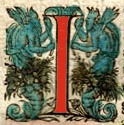
IIIIIII
![]()
| pajenn bet digoret e 2001 | page ouverte en 2001 |
Non actif |
|
Actif |
* forum du site Marikavel : Academia Celtica | dernière mise à jour 10/10/2024 17:51:24 |
![]()
A B C D E F G H I J K L M N O P Q R S T U V W X Y Z a b c d e f g h i j k l m n o p q r s t u v w x y z
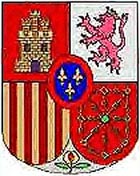 |
* Iacca : aujourd'hui Jaca, en Espagne, province de Huesca. |
|
* Iberran : nom cité par Ravenna,
108,4. Selon Rivet & Smith, p 373 : "Il s'agit probablement d'une forme corrompue. La solution le plus heureuse est qu'il représente (H)ibernia, écrit à l'emplacement de la mer entre l'Irlande et la (G)Bretagne, et mal interprété par le Cosmographe comme appartenant à la côte ouest de l'Écosse. Il pourrait tout autant représenter *(Oceanus) (H)ibern. (une forme abrégée de la Mer d'Irlande)". |
 |
 |
* Icarus : aujourd'hui Aygues, dans le département du Vaucluse, en Provence. |
 |
* Icauna : nom de rivière : l'Yonne, en France |  |
| * Icciodurum : (en attente) |
 |
* Iceavus : nom de lieu en France, département de la Côte d'Or. |
 |
* Ictis Insula : l'île de Wight, au milieu de la côte sud de l'Ile de Bretagne, sur la Manche. |
|
* Ila
Flumen : * Rivet & Smith, p. 375 : SOURCE - Ptolemy II, 3, 4 : Ila Potamon Ekbolai ( = ILA FLUVII OSTIA); var. Illa ( = ILLA) DERIVATION. Watson CPNS 47-48 thought the name obscure; it seems to have no parallels. He noted that the name produced modem Gaelic Ilidh : 'The Gaelic form does not represent Ila; it might represent *Ilia, but it may be on the analogy of the numerous stream-names in idh.' IDENTIFICATION. The river
Helrnsdale, Sutherland, flowing through Strath Ilidh
(Strath Ullie) ; as Watson notes, the strath was renamed
Helmsdale by the Norse; Helmsdale town is Dun Ilidh
and a Helmsdale man is Ileach. la rivière Helmsdale, comté de Sutherland, en Écosse. |
 |
Ilchester / Lindinae / Lindinis : Ville romaine de G. Bretagne. Angleterre; Somerset |
 |
 |
 |
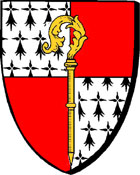 |
Ile de Bréhat / Enez Vriad : voir Bréhat. |
|
|
Ile-de-France : province de
France : - M.N. Bouillet (1863) : "Ancienne province et grand-gouvernement de France, avait pour bornes au nord la Picardie, à l'ouest la Normandie, au sud l'Orléanais et le Nivernais, et à l'est la Champagne. Elle comprenait : l'Ile-de-France proprement dite (composée elle même des pays de France au nord-ouest, de Parisis au sud, et de Goëlle à l'est), la Brie française, le Gâtinais français, le Thimerais, le Beauvaisis, le Valois, le Soissonnais, le Noyonnais et le Laonnais. Elle a formé le département de la Seine, la plus grande partie de ceux de Seine-et-Oise, Seine-et-Marne, Oise, Aisne, et une petite portion de ceux du Loiret et de la Nièvre. Cette province fut ainsi nommée parce que primitivement elle était comprise entre la Seine, la Marne, et l'Ourcq, l'Aisne et l'Oise, et formait presque une île. L'Ile-de-France a presque toujours fait partie de la couronne, excepté à la fin de la dynastie carlovingienne, époque où les ducs de France en possédaient la plus grande partie". |
|
"Iles au Nord du Monde" |
|
|
Ilkley : commune d'Angleterre; comté de Yorkshire; station britto-romaine proposée par Ordnance Survey pour l'identification d' *Olenacum - *Olicana. |
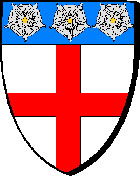 |
Ilkley : commune d'Angleterre; comté de Yorkshire; station britto-romaine proposée par Rivet et Smith pour l'identification de *Verbeia. |
 |
|
* Immadrae : aujourd'hui La Madrague (?), au cap Croisette, en Provence |
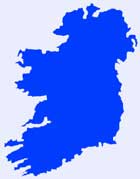 |
*Inber Domnann : l'ancien nom de la Malahide Bay, située au nord de Dublin. Le nom semble signifier : le rivage des Dumnonii. |
 |
 |
* Incarus : aujourd'hui Incaro, en Provence. |
 |
Inchtutil : forteresse romaine Victoria, en Caputh, Pertshire, en Écosse. |
 |
 |
Inishowen : presqu'île du nord-est du Donegal, en Irlande. |
 |
 |
Inishowen Head : cap extrême nord-est du Donegal, en Irlande. |
 |
 |
Inishtrahull : îlot de l'extrême nord-est du Donegal, en Irlande. |
 |
 |
* Ingena : capitale du peuple gaulois d'Armorique (= rivage de la Manche), les Abrincates / Abrincatui. Aujourd'hui, Avranches. |
 |
Inveresk : Écosse; comté de Midlothian; ancien camp romain de CORIA (VOTADINORUM) |
| Iona : L'une des îles Hébrides, en Écosse, ou
saint Colomba débarqua en compagnie de douze moines, et y fonda son
monastère avec son ordre monastique.
Y fut rédigé le Livre de Kells, |
| Irchester : |
|
Eire Iwerzhon |
Provinces et comtés d'Irlande Connacht : - Galway - Leitrim - Sligo - Mayo - Roscommon Leinster : - Carlow - Dublin - Kildare - Kilkenny - Laois - Longford - Louth - Meath - Offaly - Westmeath - Wicklow Munster : - Clare - Cork - Kerry - Limerick - Tipperary - Waterford Ulster : - Antrim - Armagh - Cavan - Derry - Donegal - Down - Fermanagh - Monaghan - Tyrone |
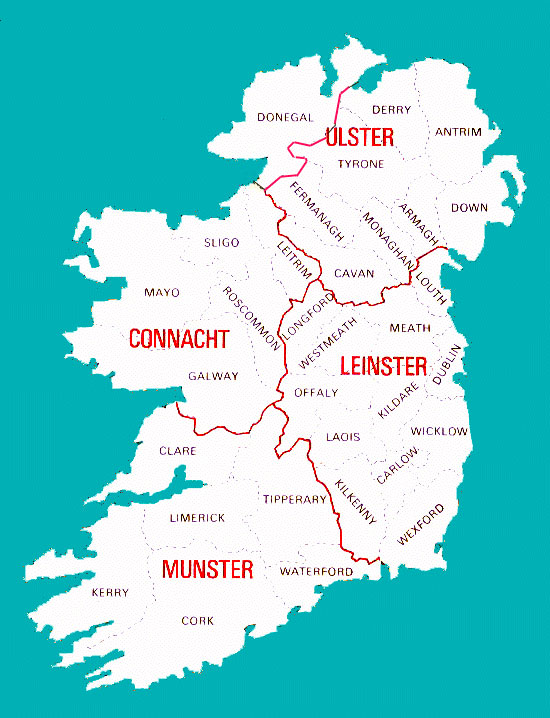 |
| Irthing : water mill. |
| Irvine Bay : Écosse; Ayrshire. Il semble, d'après les observations des chercheurs, que dans ces parages se situait l'ancien camp romain Vindogara. |
 |
Isac : rivière de Bretagne. Affluente de la Vilaine, qu'elle rejoint près de Théhillac. |
| * Isca
: radical de noms de rivières * Rivet & Smith, p. 376 et suiv. ISCA (river) SOURCE DERIVATION. The name is British *isca 'water', in the sense of 'river', which underlies not only this and the following names but also Esk and Usk. The word seems to heve left few traces in Continental toponymy (see below). Jackson mentions early Irish esc, recorded in glossaries but not in texts, explained as meaning 'water'; to this Williams adds Gaelic easg 'fen'. One must not, however, equate Isca 1 (Exe) and Isca 3 (Usk) simply and uncritically with *ïsca 'water', as has been done in the past. It is best to quote in full the analysis of Jackson in Britannia, I, (1970), 74-75 : ' The difficulty is that Caerleon is on the Usk, which is Welsh Wysg, Old Welsh Uisc, and needs British *Esca, earlier *Eisca; and that Exeter was Old Welsh *Caer Uisc (Asser : Cair Uuisc), from the same British form; though matters are further complicated by the seventeenth-century Cornish Karêsk, i.e. Kar Esk, given by Lhuyd for Exeter, which must be from *Isca not *Eska, in spite of appearances. A British *Eisca 'fishy river ' can be explained as from Indo-European *peisko- 'fish', as in Irish iasc ' fish ' which cornes from this ; as also, with different ablaut-grade, do Latin piscis and English fish. But if so, the Romano-British town-names should be Esca (i.e. Ëscâ) not Isca; and attempts by Forster, Williams, and others to explain this away, and also to account for the contradiction between Cair Uuisc and Kar Esk, are not convincing. The question must be left open.' The etymologies in question are reviewed by Nicolaisen in BZN, VIII (1957), 241-42, following in the main differing proposals of Forster. He does not favour the *peiska 'fishy water' mentioned by Jackson (now better *p(e)ik-sk-a, perhaps 'trout' rather than 'fish in général': Hamp in JIES, I (1973), 507-11), nor *peid-ska (cf. Greek pidax 'spring'). As between *eiska (with -k- suffix well documented in Celtic names) representing Indo-European *ei- ' gehen ' and the same representing *eis- ' (sich) heftig, ungestüm, schnell bewegen', Nicolaisen favours the latter, because it fits better with other river-names, including the type *Is- found in Isara and British *Isura. Nicolaisen then szparates from all these those names which he thinks directly descend from *Isca : a North and South Esk in Kincardine / Angus, an Esk in Kerry and Lough Easg of Donegal, seeing these as équivalent to Irish esc and Gaelic easg mentioned earlier. With these belong the few Continental names : Isch (a tributary of the Saar : Isca in the eighth century), Ijssche (Brabant; Isca in 822), Ischel (near Traunstein; Iscala in 984), Ischl (a tributary of the Traun; Iscala in 890), and Ischer (Alsace ; < *Iscara). To these Holder Ii. 77 adds a further assumed *Iscara and an Ambiscara. The problem to which Jackson drew attention in 1970 is in no way diminished by all this. On the one hand, all our sources for Isca-names in Britian (ten, or eleven if we include Iscalis) and the Continental examples from medieval documents all show I-; on the other hand, the derivatives in the Celtic languages demand original Esca, from what-ever origins (all the etyma proposed have original *ei-, which became e in Common Celtic and continued as e in British : LHEB 330). Given the certain identity of ancient Isca 1 and Isca 3 rivers with modem Exe (which has, like Axe, an Anglo-Saxon metathesis) and Usk (without metathesis, like Esk) rivers respectively we may not postulate some exceptional factor such as a Celtic *Esca wrongly recorded as Romano-British Isca in the first-century period when native names were becoming established in Latin form. By 1970 Jackson had evidently dropped the explanation which he tentatively gave in LHEB 259 : that short i in a British penultimate became e in Late British if the following syllable was final and contained a, and that, if Exe, Axe and Esk are from Isca ('which is uncertain'), this explains the e in these; the reason no doubt being that the resulting e is not after all the e which is demanded by medieval and modem Celtic derivatives in versions of these names. There remains one tenuous possibility, which Jackson in LHEB dismissed. It is that Isca became *Esca in the spoken Latin of Britain, just as stressed i regularly became close ê in the speech of most parts of the Empire by the third century. In LHEB 259 there is the uncompromising statement that 'the change to ç...emphatically did not occur in British Latin as we know it, though it could presumably have done so in the low-class V.L. which may have been current in the cities'. The basis of this statement is, of course, the fact that most (not all) words having stressed i that were borrowed from Latin retain this i in Welsh (e.g. fïde(m) > ffydd, cippu(m) > cyff; but as suggested by Smith in ANRW (forthcoming), there may be much learned influence in the arresting of an expected process, and on the contrary, insciptions show examples of i > e (e.g. ella for ïlla in RIB 154, Bath; stepibus for stipibus in the Lydney pavement, CIL VII, 137; baselicam in RIB 978, Netherby, A.D. 222). We then have to suppose that this Esca of spoken Latin influenced the local British pronunciation of the place-names and river-names in question. Since both places are westerly one could argue that Latin speech continued longer in them than in most other regions, and in the area of the legionary fortress at Caerleon the influence of Latin must have been considerable. This is certainly special pleading, but is at least a possible explanation of what remains a puzzling situation. The reverse would have to apply to the Gallo-Latin Isca- names of the Continent, which against expectation have preserved I- in their modem forms (despite a form Esca recorded for the river Isch of the Saar in the eighth century : Holder II 77) IDENTI FI CATION. The river Exe, Devon. |
 |
| Isca
: la rivière Usk, en Pays de Galles, comté de
Monmouthshire. * Ravenna 10827 : ISCA. |
 |
 |
* Isca Dumnoniorum : capitale britto-romaine des Dumnonii : Exeter; Angleterre. |
 |
* Iscalis : identifiée à Charterhouse-on-Mendip, en Somerset. |
 |
* Isca Silurum : station britto-romaine : Caerleon; Pays de Galles. |
 |
* Isurium Brigantium : station britto-romaine : Aldborough, en Boroughbridge; Yorkshire; Angleterre. |
 |
* Issanavantia : cité par Itinéraire d'Antonin, 4771. Voir Bannaventa / Wilton Lodge |  |
 |
Issé / *Izeg : Commune de la Bretagne historique, en Pays et Évêché de Nantes. Aujourd'hui dans la région administrative non historique dite "Pays de Loire"; département de Loire-Atlantique; arrondissement de Châteaubriant; canton de Moisdon-la-Rivière; sur le Don |
 |
Isson : commune de France; département du Puy-de-Dôme. ancien Oxone. |
| Issus : ville de Cilicie; aujourd'hui
Aiazzo. Victoire d'Alexandre sur Darius en -333. Victoire de Septime Sévère sur Pesciennus Niger en 194. Victoire d'Héraclius sur Chosroës e 622 |
| * Itis : nom de lieu donné par Ptolémée : II,3,1 : voir EITIS. Probablement une rivière du nord-ouest de l'Écosse. |
 |

|
* Itius : port de mer du nord de la Gaule Belgique; voir Portus Itius. |
| * Ituna Flumen : nom de plusieurs rivières de G. Bretagne |
 |
* Ituna Flumen : la rivière Eden, qui passe à Carlisle, en Cumberland |
|
*
Ituna Flumen : la rivière Eden, comté de Fife,
en Écosse * Rivet & Smith, p. 380 : - Ptolemy, II,3,4 : Tinea potamon ekbolai ( = TINEA FLUVII OSTOIA); var. Tinna ( = TINNA). For reasons given on p. 138, Ptolemy's form is almost certainly a corruption of *Ituna. Since no variant hints at this, the error must go back to the archetype. DERIVATION. See ITUANA -1 ( >>> rivière Eden). IDENTIFICATION : The river Eden. Fife. |
|
* Itunocelum : lieux nom
identifié de (G) Bretagne. * Rivet & Smith, The Place Names of Roman Britain, p. 380-381 : - Ravenna, 1073 : IULOCENON. - Notitia Dignitatum XL51 : "Tribunus cohortis primae Aelia Classica, TUNNOCELO". The correct form Itunocelum was first proposed by Horsley; it, and the équation between the above two forms, have been generally accepted since. ND's form is very close to the true name. Ravenna's was thought by R&C to have developed in the Greek archetype in which they believed : 'The confusion between Itunokelon and Iouliokenon is very easy, especially in capitals'; but this reasoning is not necessary, for within Latin copying. an unfamiliar first element Ituno- was garbled and then assimilated by a scribe to the well-known Iulio- (which occurs in a number of Continental place-names). For the second element, compare Ravenna's Alitacenon for *Alaunocelon (-celum). DERIVATION. For Ituna, see ITUNA-1. For -ocelum 'head, promontory', see *ALAUNOCELUM. IDENTIFICATION. Unknown. While he is probably right on thé form of thé name, Horsley's identification with Bowness (Britannia Romana (1733), 103) cannot stand; although Gale's description 'promontorium impendens aestuario', which he quotes, might be applied to Bowness Hill, the fort below it must be MAIA (q.v.). The order of names in Ravenna is Cantiventi (= Glannoventa, Ravenglass) - luliocenon - Gabrocentio - Alauna (certainly Maryport, on theriver Ellen). The only forts known between Ravenglass and Maryport are at Moresby and Burrow Walls but, as R&C remark (see also Richmond, EPNS xxn, 512), their spacing suggests that another awaits discovery. On the evidence of small fmds and the altar from Haile (RIB 796) this should be near Beckermet (NY 0104) on the river Ehen. Ekwall ERN notes that the common early form of this Egre (Eger), 'is a back-formation from, Egremont, or rather a modification of the old name under the influence of Egremont, which is a French name'. He suggests Ehen, mispronounced Eger by Normans, but it seems not impossible that this was another Ituna, or Eden. This solution allows the name Gabrosentum to be applied to Moresby, thus reconciling its recorded garrisons, but seems to leave burrow Walls without a name in Ravenna. |
|
* Itunodunum : lieux non
identifié de (G) Bretagne. * Rivet & Smith, The Place Names of Roman Britain, p. 380-381 : SOURCES -Ravenna, 10742 : ITUCODON. R&C recognised the ending as probably corrupt, but did not suggest an emendation; and regarded the first part as correct, relating Itu- to Welsh yd 'corn'. However, although c for n is not paralleled elsewhere in the British section of Ravenna, it would by no means pass belief. Final -don could represent -dono (that is, -dunum), or perhaps better, -dum, a possible form of abbreviation of -dunum on a map (cf. Uxelodum for -dunum on theRudge Cup). DERIVATION. For Ituno-, see ITUNA-1. For -dunum, see BRANODUNUM. IDENTIFICATION. Unknown, but from its position in Ravenna this should be an unlocated Roman fort on the Fife Eden. ---------------- Identification : "Non identifié, mais selon sa position donnée par Ravenna, il se pourrait qu'il s'agisse du fort romain non identifié sur la rivière Eden du comté de Fife" (Écosse). |
| * Iuctius : nom cité par Ravenna, 10829; selon Rivet & Smith, p 381 : voir STUCTIA (rivière Ystwyth) |
 |
* Iuliocenon : voir Itunocelum, ci-dessus |
|
*
Ivernium : * Rivet & Smith, p 381-382 : SOURCE : Ravenna, 10616 : IBERNIO. One may assume that here b is for v, as often. Derivation : This represents British *Iuernio- 'place on the *Iuerno 'river', the name of the settlement or fort being formed from the river-name with the *-io- suffix, as is common. This river (> Iwerne) is identical with the old name of the Kenmore river of Ireland, given by Ptolemy as Iernou, gen. (= Iernus; n, 2, 3), but to be corrected to Iouernou (= Ivernus). Related are the name of Ireland itself, *Iuernia (Hibernia), and personal names such as Iberna of RIB 377 (Caerleon). The above all seem to have initial i-, which leads Jackson to reject Ekwall's proposed etymology (for the rivers) in Celtic *ïuos 'yew', for this has i-; and equally, then, Williams's sense for the present name of yew-tree place' is to be discarded also. O'Rahilly examines various other etymologies that have been proposed for the group, arguing that the names in I- are by-forms of other names in E-, and recalling that river-names and divine names often coincide because the river is the manifestation of the deity; hence 'the goddess-names *Everna, *Everiu would thus appear to mean "she who travels regularly, she who moves in a customary course", from which we infer that the goddess so designated was the sun-goddess. . . 'See O'Rahilly in Eriu, XIV (1946), 7-28, and Jackson in JRS, XXXVIII (1948), 57; also Holder II 99". IDENTIFICATION. Unknown. Apparently a place on the river Iwerne, Dorset, but there is no obvious candidate : the Roman fort on Hod Hill (identified by us as Dunum) had a very short life and neither it nor any of the villas in the neighbourhood is related to any known Roman road. Perhaps one of them (such as the celebrated building excavated by Pitt-Rivers south-west of Iwerne Minster) may prove to be part of a larger settlement. Alternatively the reference may be to the river itself. ------------------------------------- Identification : inconnue. peut-être la rivière Iwerne, Dorset. |
 |
Ivrea : Italie; Aoste; autrefois : Eporedia. |
![]()